Album Weeds – Fiji
1871. No surcharge; 1d., 3d. & 6d.
 One Penny. Genuine
One Penny. Genuine
Engraved in épargne, on thin, soft, white wove paper, badly perforated 125, watermarked FIJI POSTAGE through the middle row of stamps in the sheet. The dark shading at the bottom of the crown is in a perfectly straight line. The ends of all the white strokes, forming the letters C R, are tapered off until they are quite fine; but they get wider in the center, as they would in ordinary written capitals, made with pen-and-ink. The central circle is surrounded by sixty white pearls, all circular in shape, and of one uniform size. The bottom of the P of POSTAGE is a little sloped off, so as not to touch the outline of the frame to the left of it. The Y of PENNY has its arms splayed out far too much. The whole of this lower inscription is slightly sunk into the paper, almost as though it had been done with type. The outline of the circle, just inside the pearls, is formed by a very thin, colored line, between two thin, white ones.
One Penny. First Forgery
Lithographed, on very white paper, thicker than the genuine, pin-perforated what seems to be about 15, but so extremely badly done that it is impossible to say what is the proper gauge; no watermark. The dark shading at the bottom of the crown is considerably curved or rounded downwards in the center. The strokes forming the letters C R are, as nearly as possible, the same thickness, throughout their whole length. The central circle contains only fifty-five pearls, and they are oval instead of round, and some of them smaller than the others. The bottom of the P of POSTAGE is joined to the frame to the left of it. The Y of PENNY is of the normal shape; i.e., the arms are not unduly splayed out. As the stamp is a lithograph, I need hardly say that the lower inscription does not show any appearance of being sunk into the paper, but is perfectly flat. The outline of the circle, immediately inside the row of pearls, is composed of one broadish white line only.
One Penny. Second Forgery
This is not nearly so good an imitation as the last. Lithographed, on soft paper, very like that of the genuine; no watermark; perforated 14. The dark shading at the base of the crown is rounded downwards, instead of being in a straight line, and the crown itself is extremely blotchy and indistinct. The letters C R are tapered more like the genuine than the first forgery; but their outline is ragged. There are only fifty-two pearls in the circle, and they are very irregular, both in shape and size. The P of POSTAGE does not touch the side of the frame to the left of it, but the bottom of the letter is not sloped off at all. The T of the; same word is very tall and lanky; the O of ONE is very much smaller than the NE; and the E of PENNY has hardly any indication of a central tongue. This inscription is not sunk into the paper.
 Threepence. Genuine
Threepence. Genuine
Paper, watermark, perforation, etc., the same as in the genuine one penny. The design of this stamp is different from that of the penny, the circle having sixty-nine dark dice, alternating with sixty-nine light ones, instead of pearls. The crown and the letters C R are the same as in the genuine penny.
Threepence. Forged
Lithographed, on thin, white wove paper, rather harder than the genuine; no watermark; perforated 12 1/2. Except for the inscription— POSTAGE THREE PENCE—this stamp is an exact copy of the first forgery of the penny, having the fifty-five pearls, the rounded base to the crown, the C R in letters of uniform thickness, etc.
 Sixpence. Genuine
Sixpence. Genuine
Paper, watermark, perforation, etc., the same as in the genuine one penny. This stamp again is different from either of the other values.
The outline of the central circle is composed, not of pearls, as in the one penny, nor of little white dice, or rectangles, as in the threepence; but of a pattern of thirty-nine dark zig-zags, on a lighter ground. The base of the crown is straight; the letters C R are tapered nicely at their ends, as before; the lower corners, above POS of POSTAGE, and above NCE of PENCE, contain large triangles, composed of white dots. The ends of the upper label, containing the name, are of peculiar, curly ornaments, in place of the crosses of the one penny and threepence values. The tail of the s of six is drawn considerably too long, as are also the lowest strokes of both the first and second E of PENCE. A hexagon of white lines is visible in the central circle.
Sixpence. First Forgery
Lithographed, on white wove paper, similar to that of the genuine, but harder; no watermark; perforated 12. The forgers have copied nearly the whole of this stamp from the forged one penny. The outline of the circle contains fifty-five pearls, instead of the zig-zag line of the genuine. The base of the crown is rounded downwards. The letters C R are of uniform thickness throughout, instead of being tapered at their ends. The triangles, above POS of POSTAGE;, and above ENCE of PENCE, are formed each of one broad, white line, instead of dots. This is very conspicuous. The ends of the upper label are copied from the genuine sixpence. Each E of PENCE is of the normal shape, as is also the S of Six, though they are very much out of shape in the genuine. There is no hexagon in the central circle.
Sixpence. Second Forgery
Electrotyped, in a sort of violet-carmine, on stout, green wove paper, no watermark, perf. 9 1/2! The central circle is bounded by zig-zags, as in the genuine, and four out of the six white lines of the hexagon in the said circle are visible. The bottom part of the crown is rounded, but not so much so as in the first forgery. After the paper and perforation, the easiest test for this counterfeit is the white band at the base of the crown. In the genuine (in all issues and values) this white band is ornamented with five ermine-spots or “tails”; each represented by a sort of small >, lying on its side, with the sharp point to the right. In the forgery, this band is plain white, without any ermine spots. I never saw this forgery until 1891.
 1872. Same stamps surcharged 2, 6 & 12 Cents.
1872. Same stamps surcharged 2, 6 & 12 Cents.
These are exactly the same as the genuine stamps described above, except that the one penny is surcharged in black TWO CENTS, the threepence is surcharged SIX CENTS, and the sixpence
is surcharged TWELVE CENTS.
First Forgery
These will easily be detected, as they are simply the first set of forgeries just described, with the surcharge added. Both the above-described forgeries of the one penny value are found with the TWO CENTS surcharge.
Second Forgery
These are very much more dangerous, being’ the genuine stamps of the 1871 set, with forged surcharge. I am sorry to say that they passed through my hands at a time when I had no opportunity of taking notes of the surcharge; but, as far as I remember, the types used to print the surcharge on the forgeries were well-nigh identical with those used for the genuine; so that collectors would do well to make quite sure of the source whence those offered to them for sale were procured.
 1875. 2c., 6c„ 12c., with “V.R.”
1875. 2c., 6c„ 12c., with “V.R.”
There are two varieties of the “V.R.” surcharge; the one in Roman capitals, and the other in (so-called) “Gothic” letters. They are usually divided in the catalogs, as though they were distinct issues; but, as a matter of fact, both of them (together with many sub-varieties) are found on the same sheet.
Roman V.R.; 2c., 6c. & 12c.
Genuine
From the center of the V to the center of the R, there is a distance of 4 millimeters; and, from the center of the stop after the V to the center of the stop after the R, there is also a distance of 4 millimeters. The stops are large.
Forged
The letters are a great deal too far apart. From the center of the V to that of the R, the distance is very nearly 8 1/2 millimeters, and there is also a distance of 8 1/2 millimeters between the two stops. The said stops are very small, and the one after the V is placed rather below the level of the bottom of the letter.
“Go thic” V.R.; 2c, 6c. & 12c.
thic” V.R.; 2c, 6c. & 12c.
Genuine
The center of the letters, V.R., are 4 1/2 millimeters apart, and the centers of the stops are 4 1/2 millimeters apart. The little cross-strokes in the sides of the V are level with each other; and the side-lines are broken to allow of the admission of the said cross-strokes. The vertical, first stroke of the R is similarly broken in the center, to allow the thick cross-stroke to pass through it. The top of this vertical stroke projects only very slightly to the left. The rounded part of the head of the R has a projection to the right. In normal copies, the stops are nicely-shaped diamonds, with concave sides; both being the same size and shape.
Forged
The centers of the letters, V.R., are very nearly 6 millimeters apart, and the centers of the stops are 5 1/2 millimeters apart. The cross-stroke in the left side of the V is decidedly higher than the other. The whole letter is in one piece, so that there is no break for the admission of the cross-strokes. (The same is the case with the R.) The top of the first, or vertical, stroke of the R projects considerably to the left, in the shape of a clumsy blotch. The rounded part of the head of the R is like that of an ordinary Roman R, without any projection. The stops are very shapeless, the one after the V being considerably larger than the other.
 1882. Five Shillings, black and salmon-red.
1882. Five Shillings, black and salmon-red.
Genuine
Engraved in épargne, on medium, white wove paper, perf. 10. There are eleven distinct pearls outside the curved white line above FIJI; the one to the extreme left touches the frame around the 5, and the corner of the white line runs into this pearl. The last pearl but one to the right is almost exactly above the last I of FIJI. The bottom of the F of the lower FIVE is cut off slantingly down, from left to right. The pearls on stalks in the Queen’s crown are large and round. The ornaments between the said pearls are a thistle, a shamrock, and a thistle; the shamrock being very much lower than the pearls each side of it. The profile is not outlined; being formed, as usual, merely by the stoppage of the horizontal lines of the background. The chin projects somewhat. There is a tolerably long curl hanging from the chignon.
Forged
Electrotyped, on medium, white wove paper, ungummed. This has probably been made as an illustration to some cataloge, for the perforation is merely printed round the stamp. If pierced, it would gauge 11 1/2 x 11, etc. There are eleven pearls above FIJI, but the eleventh to the left is a mere abortion, which does not touch the frame round the 5, and is at the top of the line, instead of at the corner of it. The last pearl but one to the right is far to the right of the last I of FIJI. The bottom of the F of the lower FIVE is rounded. The pearls on stalks in the crown are very indistinct, and two of them seem to be diamond- shaped. The ornaments between the said pearls are a thistle (very badly shaped, and far too short), a very tall fleur-de-lys, and a shapeless object, to represent a thistle. The profile has a distinct, dark outline, and the chin is very retreating. There is a dark, projecting lump below the chignon, but it is not at all like a curl. The central medallion is pink, instead of salmon-red.
Postmarks
Genuine.—65, without numerals. The lines must have been highly embossed on the hand-stamp, and with sharp edges; for they cut through the stamp, and sometimes even through the paper of the envelopes to which the stamps are affixed. I suppose the Fiji postal authorities are resolved that the stamps shall never do duty a second time.
Forged.—10, 76, 100.
Private Stamps – “FIJI TIMES EXPRESS.”
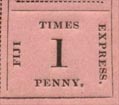 1870. 1d., black on rose.
1870. 1d., black on rose.
Genuine
Type-set; printed in black, on rose-coloured, quadrille paper, or on laid bâtonné, rouletted 20, on dotted lines. The numeral 1 is just 4 millimeters high at the highest point. A line drawn along the tops of the letters of PENNY would cut almost centrally through the last S of EXPRESS. T h e horizontal line above TIMES, and the similar one below PENNY, are a great deal thicker than any of the other lines. In my specimen, the line above TIMES is broken just before the T ; and the one below PENNY is broken in two places, below the centre of each N of that word.
Forged
Type-set, on stout, violet-rose wove paper, and also on very pale, rose laid paper rouletted 20, on dotted lines, or pin-perf. about 12. The 1 is 5 3/4 millimeters high at its highest point. A line drawn along the tops of the letters of PENNY would pass just clear below the last S of EXPRESS. All four lines of the frame are, as nearly as possible, the same thickness, and the top and bottom lines are not broken anywhere.
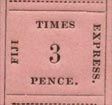 1870. 3d., black on rose.
1870. 3d., black on rose.
Genuine
Paper, printing, etc., same as in the genuine one penny. The numeral is a plain 3.
Forged
The 3 is an ornamental numeral, with an outline all round it. The top line is broken above the S of TIMES, and the bottom line is broken under the P of PENCE. The other tests are the same as for the forged one penny.
1870. 6d., black on rose.
Genuine
Paper, printing, etc., the same as in the genuine one penny. The top line is broken, in my copy, above the E of TIMES; and the bottom line is broken in two places, below the beginning and end of the E of PENCE. The 6 is a plain numeral, nearly 7 millimeters high.
Forged
The top line is unbroken; the bottom line is broken below the end of the E of PENCE. The 6 is just five millimeters high; it is an ornamental numeral, with an outline all round it. The other tests are the same as for the forged one penny.
1870. 9d., black on rose.
Genuine
The numeral is plain, but I do not know the The top line is broken above the end of the S of TIMES, and the bottom line is broken under the P of PENCE. The 9 is a plain numeral this time, very nearly 6 millimeters high. The other tests are the same as in the forged one penny.
1870. 1s., black on rose.
Genuine
Paper, printing, etc., as in the genuine one penny. The top line, in my copy, is broken, above the E, and beyond the end of the S, of TIMES; and the bottom line is broken, below the end of the H, and below the beginning of the second L, of SHILLING. The I is an ornamental numeral (the only one of the set); it is 6 millimeters high, and has an outline all round it.
Forged
My specimen, on wove paper, has the top line unbroken. The bottom line is extremely thin, but it appears to be unbroken. The left-hand line is broken, opposite the first I of FIJI, and the right-hand line is broken, opposite the P of EXPRESS. In one specimen, on laid paper, the top line is unbroken, the bottom line is also unbroken, the left-hand line is broken, opposite to the first I of FIJI, and the right-hand line has a wide gap, opposite to the space between the R and second E of EXPRESS. In another specimen on the laid paper, the top line is broken, above the E of TIMES, the bottom line is broken, below the second L of SHILLING, the left-hand line is broken by the J of FIJI, and the right-hand line is broken, opposite to the R of EXPRESS.
Soi-disant “reprints” of the Times Express stamps
Bacon’s Reprints says that so-called “reprints” of all five values were made in 1876, on laid, bâtonné rose paper. The stamps are shorter (16 mm., instead of 18 1/2 mm.), and differ in type; and the 6d. has a small numeral of value, instead of a large one. They are unperforated, also pin-perf.
NOTE.—The “rouletting on colored lines” is done in these stamps (genuine and forged) by notched (brass ?) rule, which is rather higher than the type. The rule gets inked with the rest of the impression, and when the platen descends, the pressure which forces the paper down on the types, also forces the notches in the rule through the paper, making a row of cuts, while the sides of the notches ink the paper, making a row of dashes.
From: ‘Album Weeds’, 3rd edition by R. B. Eareé. 1906
 See also
See also

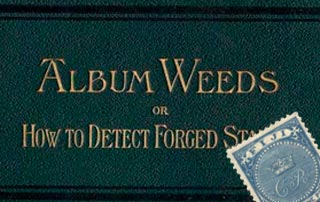
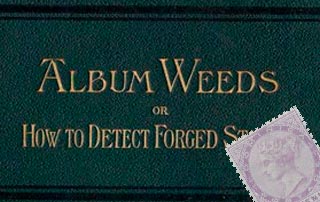
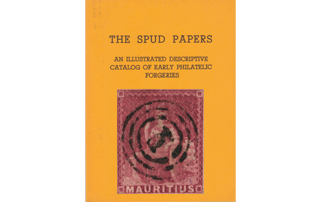
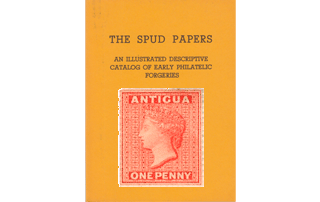
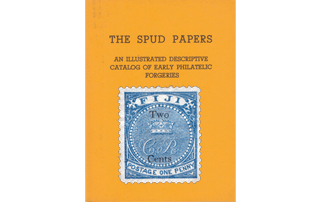
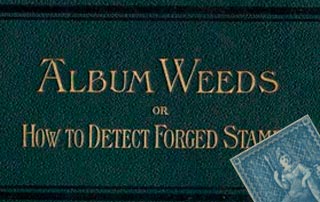
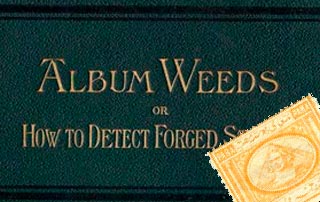
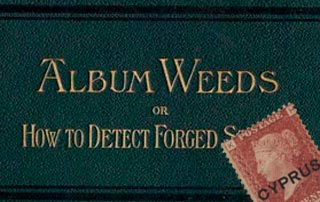
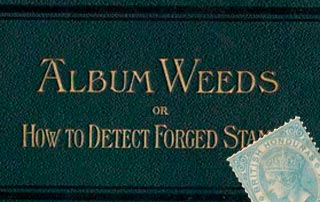
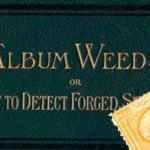
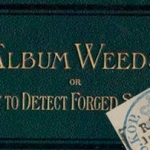
Leave a Reply
Want to join the discussion?Feel free to contribute!